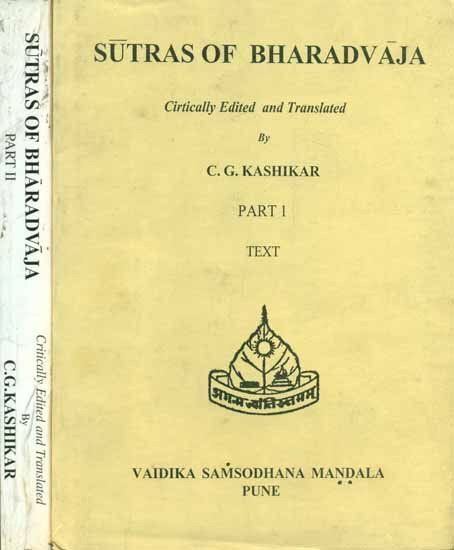Bharadvaja-srauta-sutra
by C. G. Kashikar | 1964 | 166,530 words
The English translation of the Bharadvaja-Srauta-Sutra, representing some of the oldest texts on Hindu rituals and rites of passages, dating to at least the 1st millennium BCE. The term Srautasutra refers to a class of Sanskrit Sutra literature dealing with ceremonies based on the Brahmana divisions of the Veda (Sruti). They include Vedic rituals r...
Praśna 12, Kaṇḍikā 8
1. should fix up a peg near the pin thrust at the joint of the northern pole with the axle of the northern Havirdhāna-cart with the verse, “I shall proclaim the heroic deeds of Viṣṇu who measured out the earthly regions, who supported the upper abode, traversing the space of three steps, the wide-going.”[1]
2. The two should tie up their respective Havirdhāna-carts to the pegs with the formula, “Thou art the thread of Viṣṇu.”[2]
3. With the formula, “Thou art the fixed point of Viṣṇu,”[3] the Adhvaryu should tie a knot.
4. The first of the knots which he has tied should be marked out.[4]
5. The carts should (thus) be stuck on the rear side.
6. The yoke-pins should be directed upwards and tied on the upper sides (to the yoke with a cord).
7. Having fixed up two posts in front of the two Havirdhāna-carts, and having placed upon them a bamboo with its end turned towards the north, the Adhvaryu should fix upon it a frontlet made of iṣīka grass (rarāṭī)[5] with the formula,“Thou art the forehead of Viṣṇu.”[6]
8. He should stitch up a cane crosswise on the frontlet with the formula, “Thou art the thread of Viṣṇu.”[7]
9. With the formula, “Thou art a fixed point of Viṣṇu,” he should tie a knot.
10. The first of the knots which he has tied should be marked out.[8]
11. With the formula, “Thou art the back of Viṣṇu,”[9] he should put the middle roof.[10]
12. With the formula, “You two are the mouth-corners of Viṣṇu,”[11] he should fasten the ends of the frontlet (to the bamboo).[12]
13. He should put mats and sticks into the vacant regions one by one.
14. They call these antarvartas.[13]
15. The Adhvaryu should enclose the Havirdhāna with the verse, “May these songs, O rich in praise, encompass thee; may the swellings encompass thee, rich in swellings; may the favours be favourable to thee.”[14]
16. The Adhvaryu should leave (that is, arrange for) two doors, the eastern and the western.
17. (So that) simultaneous sight can be secured of the Śālāmukhīya[15] fire, the Hotṛ’s fire[16] and the fire on the uttaravedi.
18. The Adhvaryu should sew round the southern posts[17] of both these doors; the Pratiprasthātṛ, of the northern ones, with the formula, “Thou art the thread of Viṣṇu.”[18]
19. (Each one) should tie the knot with the formula, “Thou art the fixed point of Viṣṇu.”[19]
20. The first of the knots which each may tie up should be marked out.[20]
Footnotes and references:
[1]:
Taittirīya-saṃhitā I.2.13.3.
[2]:
Taittirīya-saṃhitā I.2.13.3.
[3]:
Taittirīya-saṃhitā I.2.13.3.
[4]:
So that it might be untied at the proper time. See: XIV.25.7. cf. Taittirīya-saṃhitā VI.2.9.
[5]:
Satyāṣāḍha-sūtra VII.5.
[6]:
Taittirīya-saṃhitā I.2.13.3.
[7]:
Taittirīya-saṃhitā I.2.13.3.
[8]:
XIV.25.7.
[9]:
Taittirīya-saṃhitā I.2.13.3.
[10]:
Three aratnis broad and nine aratnis long according to Āpastamba-śrauta-sūtra XI.8.1.
[11]:
Taittirīya-saṃhitā I.2.13.3.
[12]:
According to some teachers, he should touch it with this formula, cf. Āpastamba-śrauta-sūtra XI.8.4.
[13]:
Taittirīya-saṃhitā VI.2.10.7.
[14]:
Taittirīya-saṃhitā I.3.1.2,3.
[15]:
That is, the Āhavanīya fire in the prāgvaṃśa which is now regarded as the Gārhapatya fire.
[17]:
The text reads: dakṣiṇe dvāryāv adhvaryuḥ etc. The correct text would be: dakṣiṇe dvārye adhvaryuḥ.
[18]:
Taittirīya-saṃhitā I.2.13.3.
[19]:
Taittirīya-saṃhitā I.2.13.3.
[20]:
XIV.25.7.
